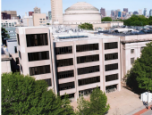
DUSP Climate Action Plan
Executive Summary
In light of the climate crisis and the impacts already being felt around the world and in our own backyard, institutions such as MIT have a responsibility to mitigate their greenhouse gas (GHG) emissions. This work is crucially important as we know that those who have contributed the least to global carbon emissions will feel the impacts of climate change the most. As such, institutions must leverage their privilege and resources to reduce these disparate impacts. While there is much that can and should be done at the institutional level, individual departments may have even more flexibility and agency to make change. MIT’s Department of Urban Studies and Planning (DUSP) should lead by example through immediate action to reduce its GHG emissions and environmental impact. DUSP has demonstrated that it feels this urgency, through the support of DUSP Climate’s departmental recommendations in Spring 2019 and the selection of climate change as the faculty’s primary issue of concern in a 2017 visioning exercise; now is the moment to act.
The following report introduces our theory of change for how the department can use specific actions to reduce GHG emissions and environmental impact, as well as generate various co-benefits (including financial savings, alignment with our departmental values, and increased awareness). DUSP has three roles to play in this effort: 1. educating “changemakers”; 2. modelling change by demonstrating how to effectively reduce GHG emissions an environmental impact; and 3. becoming an “agent of change” by developing new solutions, advocating for political action, and leveraging its status as a renowned urban planning institution to elevate the importance of this work.
From this framework, we began our analysis by calculating an emissions baseline for DUSP from readily available data for travel (flying and commuting), building energy use, procurement, and waste. We calculate that DUSP’s current annual GHG emissions are an estimated 1,917.9 metric tons of CO2 equivalent (MTCO2e). With an understanding of the proportion of our emissions in each category, we then include recommendations to the department with specific actions by category, as well as recommendations for how to formalize these efforts. The most important next step will be to dedicate staff time (beginning at 50% FTE) and two 50% student Research Assistants to implement the next stages of this process. These three individuals will initially be responsible for carrying out a community engagement process, improving the baseline emissions calculations, and implementing recommendations over time as pilot projects.
This report is the work of four DUSP students over the course of a semester, and does not represent the views of all students within the department. Now is the moment for conversations amongst ourselves to determine how to make this type of action a priority for the department, decide on next steps, and discuss the tradeoffs we are willing to make. The following analysis may act as a guide for this process, but more collective reflection is needed to define the path forward.


